Large tables can pose challenges for many operations when working with a database. Occasionally, we may need to modify the table definition. Since RDS replication does not use asynchronous for its replication, the typical switchover procedure is not feasible. However, the Blue/Green feature of RDS utilizes asynchronous replication, which allows us to update the table definition of large tables using the switchover procedure.
The Blue/Green deployment strategy involves creating two separate but identical environments for an application. The current environment where the application runs is referred to as “Blue,” while the environment that contains the modifications or new version is called “Green.” This continuous deployment method allows the database to be updated with minimal downtime.
In this blog post, I will demonstrate how to alter a table whose primary key is nearing its maximum value using the Blue/Green environment.
For the following blog, please assume the following environment:

We can create a Blue/Green environment with the aforementioned environment in mind. This process will establish a new environment that mirrors the structure of the production environment. Please note that to create a Blue/Green environment, the cluster parameter must have binlog_format set to row.
To create the Blue/Green environment, use the dropdown menu for actions and select the “Create Blue/Green Deployment” button.
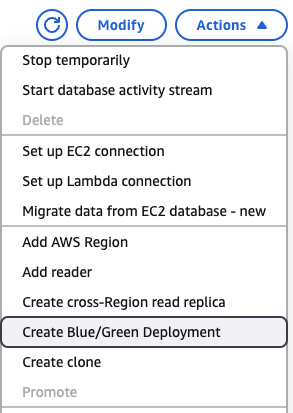
Set the identifier of the deployment:

Before creating the Blue/Green environment, please review the configuration carefully. Remember that you can change the Aurora version during the creation process. This option allows for validation checks before the upgrade since all data will be replicated in the green environment.
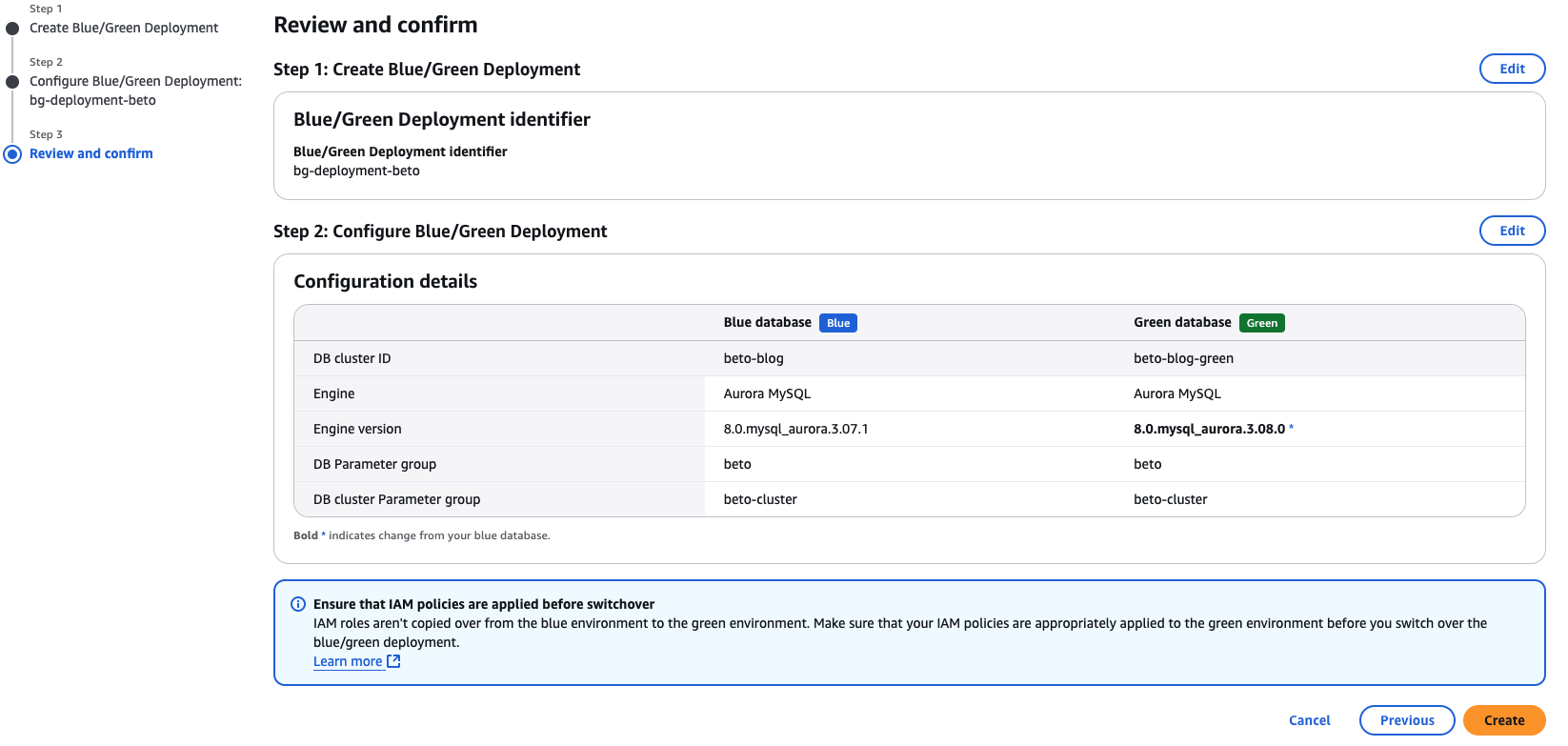
After creation, please wait until all nodes in the green environment are available.
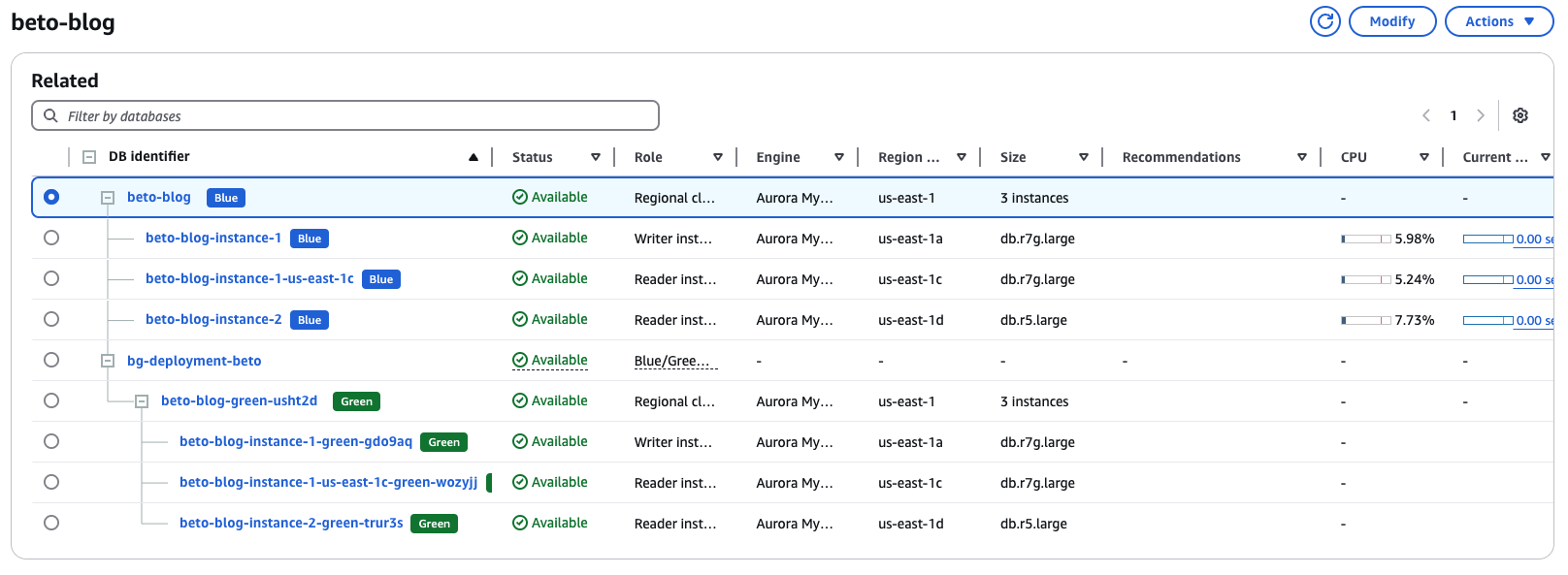
Having the nodes available allows us to begin the modification process. However, changing the column data type in a replica environment may lead to replication issues. To avoid this, since we are increasing the column type from int to bigint, we need to set the value of replica_type_conversions in the cluster parameter group. We will set this variable to ALL_NON_LOSSY (https://dev.mysql.com/doc/mysql-replication-excerpt/8.0/en/replication-features-different-data-types.html).
It’s important to take note of the following bug report: https://bugs.mysql.com/bug.php?id=82599, which could cause issues when using unsigned data. Once we have completed the necessary steps, we can proceed with all the required alterations.
Stopping the replica:
1 2 3 4 5 6 7 8 | MySQL - Green > CALL mysql.rds_stop_replication; +-----------------------------+ | Message | +-----------------------------+ | Replica is down or disabled | +-----------------------------+ 1 row in set (1.02 sec) Query OK, 0 rows affected (1.02 sec) |
Consider the following table definitions for the changes:
1 2 3 4 5 6 7 8 9 10 11 12 13 14 15 16 17 18 19 20 21 22 | MySQL - Green > SHOW CREATE TABLE joinitG *************************** 1. row *************************** Table: joinit Create Table: CREATE TABLE `joinit` ( `i` int NOT NULL AUTO_INCREMENT, `s` varchar(64) DEFAULT NULL, `t` time NOT NULL, `g` int NOT NULL, PRIMARY KEY (`i`), KEY `g_fk` (`g`), CONSTRAINT `joinit_ibfk_1` FOREIGN KEY (`g`) REFERENCES `joinit_fk` (`i`) ON DELETE RESTRICT ON UPDATE CASCADE ) ENGINE=InnoDB AUTO_INCREMENT=4653058 DEFAULT CHARSET=latin1 1 row in set (0.02 sec) MySQL - Green > SHOW CREATE TABLE joinit_fkG *************************** 1. row *************************** Table: joinit_fk Create Table: CREATE TABLE `joinit_fk` ( `i` int NOT NULL, PRIMARY KEY (`i`) ) ENGINE=InnoDB DEFAULT CHARSET=utf8mb4 COLLATE=utf8mb4_0900_ai_ci 1 row in set (0.01 sec) |
Doing the alter change:
1 2 3 4 5 6 7 8 9 10 11 12 13 14 15 | MySQL - Green > ALTER TABLE joinit DROP FOREIGN KEY joinit_ibfk_1; Query OK, 0 rows affected (0.03 sec) Records: 0 Duplicates: 0 Warnings: 0 MySQL - Green > ALTER TABLE joinit MODIFY COLUMN g bigint NOT NULL; Query OK, 4194391 rows affected (1 min 39.09 sec) Records: 4194391 Duplicates: 0 Warnings: 0 MySQL - Green > ALTER TABLE joinit_fk MODIFY COLUMN i bigint NOT NULL; Query OK, 60 rows affected (0.09 sec) Records: 60 Duplicates: 0 Warnings: 0 MySQL - Green > ALTER TABLE joinit ADD CONSTRAINT joinit_ibfk_1 FOREIGN KEY (`g`) REFERENCES `joinit_fk` (`i`) ON DELETE RESTRICT ON UPDATE CASCADE; Query OK, 4194391 rows affected (1 min 45.66 sec) Records: 4194391 Duplicates: 0 Warnings: 0 |
After completing the process, we can start the replication and wait for it to catch up.
1 2 3 4 5 6 7 8 9 10 11 12 13 14 15 16 17 18 19 20 21 22 23 24 25 26 27 | MySQL - Green > CALL mysql.rds_start_replication; +---------------------------+ | Message | +---------------------------+ | Replica running normally. | +---------------------------+ 1 row in set (2.18 sec) Query OK, 0 rows affected (2.18 sec) MySQL - Green > SHOW REPLICA STATUSG *************************** 1. row *************************** Replica_IO_State: Waiting for source to send event Source_Host: 10.1.15.0 Source_User: rdsrepladmin Source_Port: 3306 Connect_Retry: 60 Source_Log_File: mysql-bin-changelog.000004 Read_Source_Log_Pos: 112774 Relay_Log_File: relaylog.000002 Relay_Log_Pos: 82470 Relay_Source_Log_File: mysql-bin-changelog.000004 Replica_IO_Running: Yes Replica_SQL_Running: Yes [...] Seconds_Behind_Source: 0 [...] 1 row in set (0.01 sec) |
Maintaining the replica in sync will enable the switchover; it’s also highly recommended that you stop the application writes during the switchover procedure.
By selecting the deployment option from the action button in the top right, we can access the switchover button action:
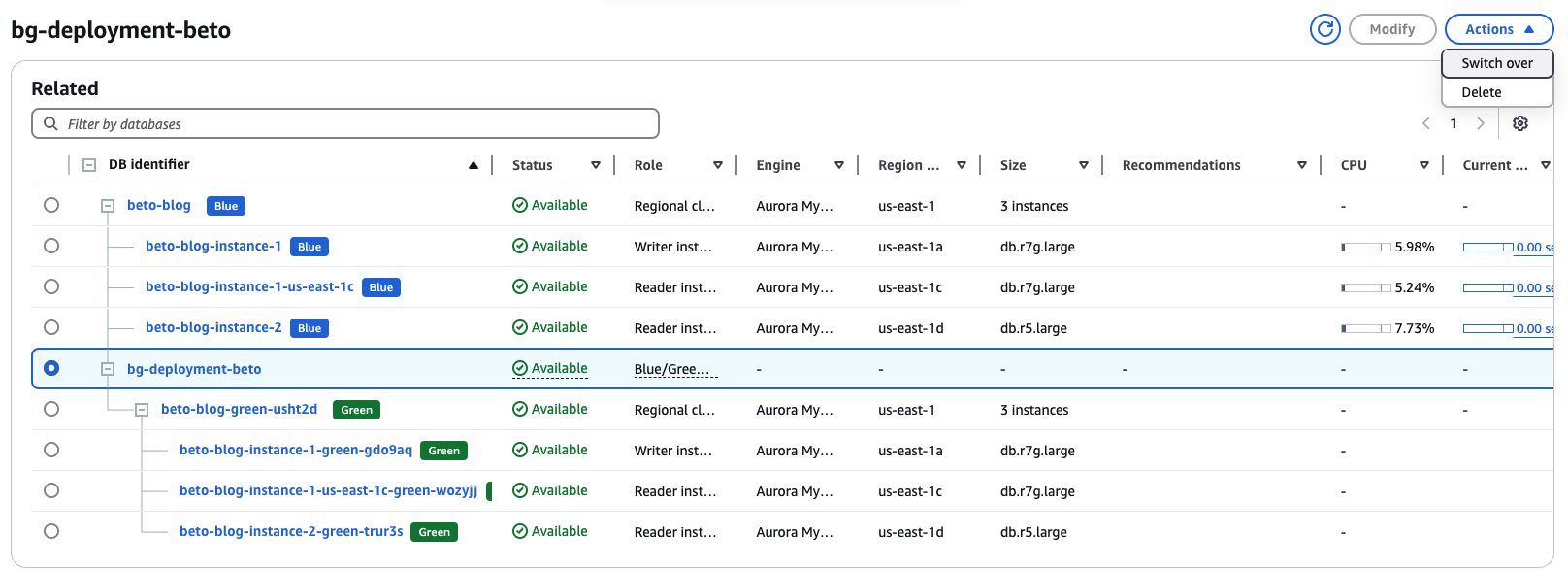
After clicking, a panel will appear to switch over:
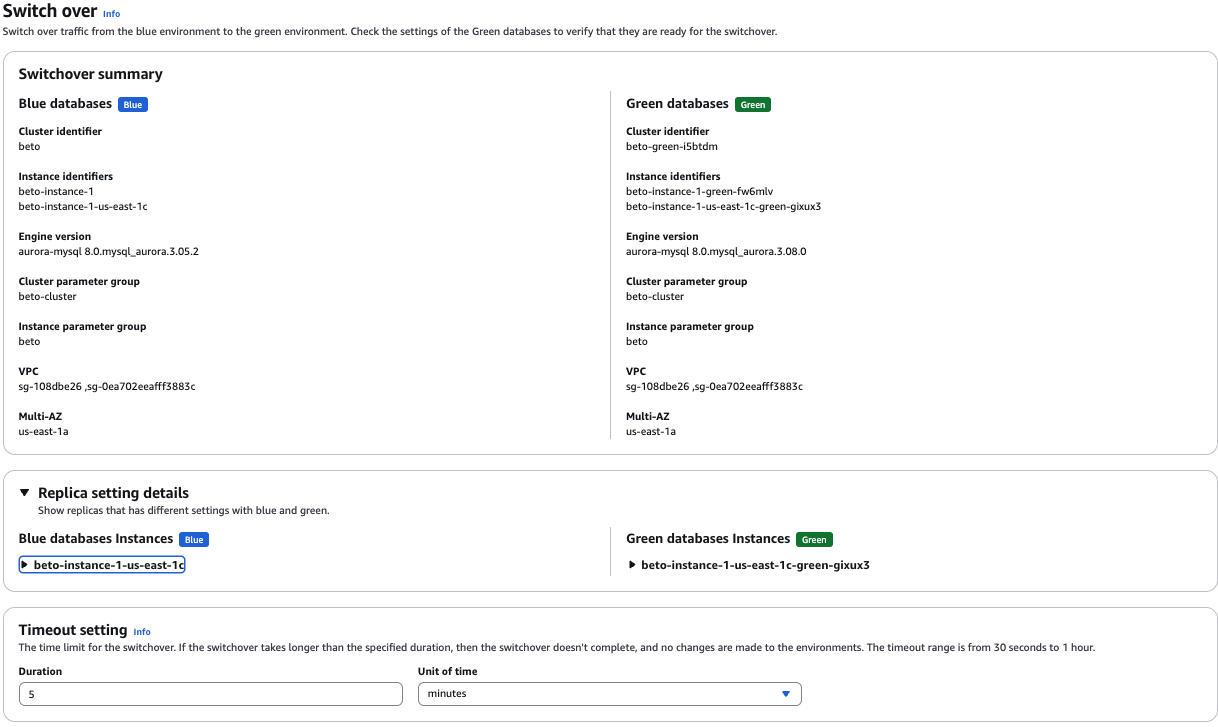
Now, we just need to wait for the switchover:
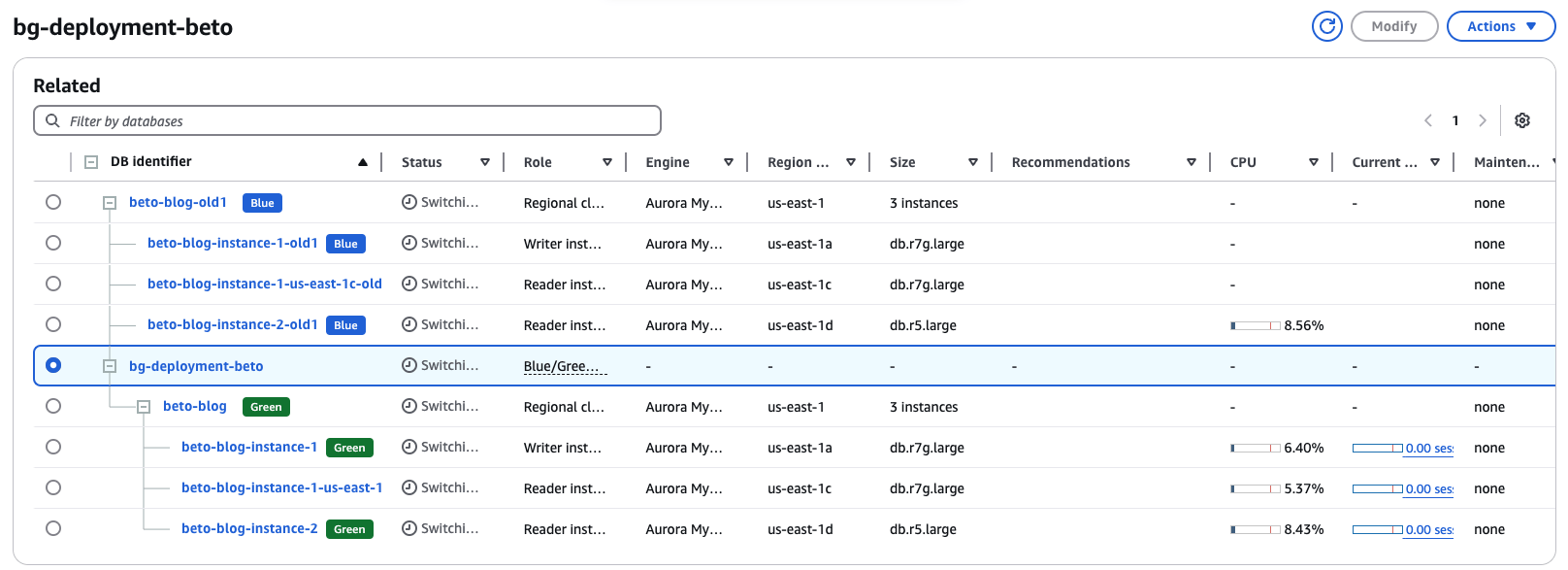
After the procedure is complete, we can see that the green nodes, which are the ones where we changed the columns, are now referred to as “new-blue.” These nodes already have the endpoint used by the application. The blue environment is now called “old-blue”:
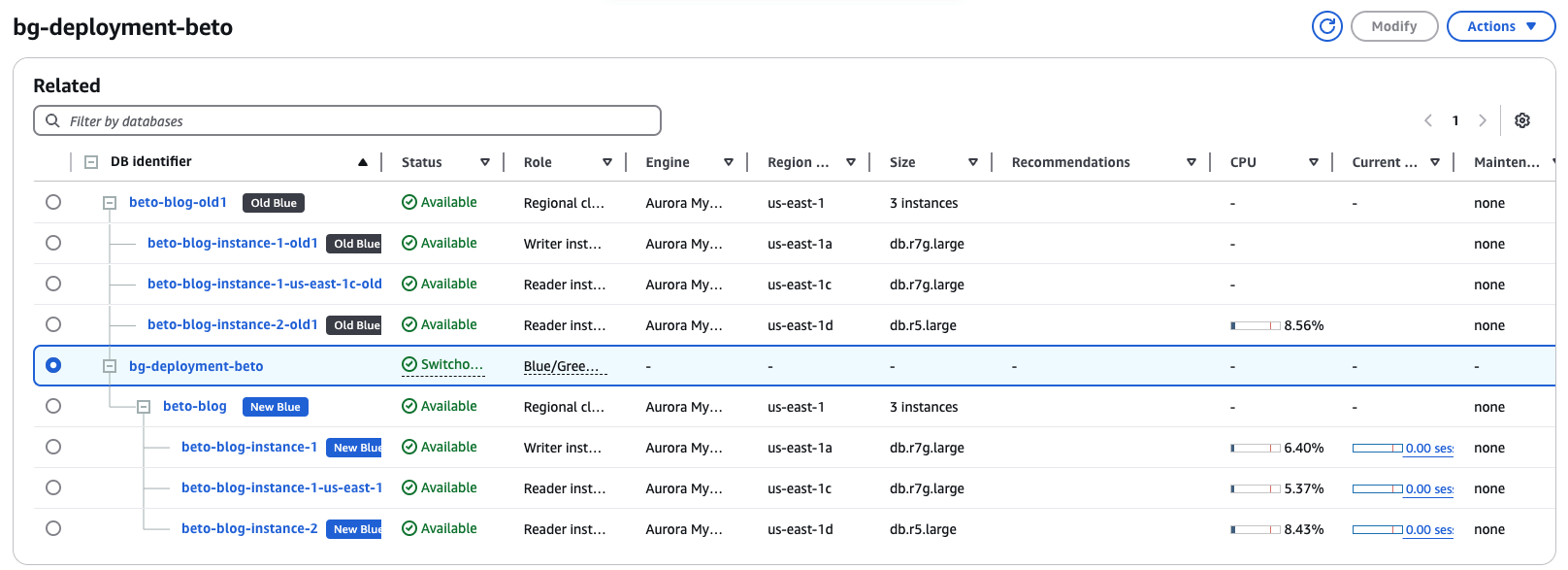
Once completed, we can perform any needed validation before deleting the nodes. The application can now return to regular operation, and after the validations are done, the deployment and old blue versions can be deleted.
Conclusion
The switchover procedure is a common practice used for various purposes; however, as previously mentioned, it cannot be accomplished using standard RDS replication. This limitation arises because RDS replication does not use the default asynchronous replication method found with MySQL’s binary log. Therefore, adopting a Blue/Green deployment strategy is a viable solution.
For further reads regarding blue/green deployments, please refer to https://docs.aws.amazon.com/AmazonRDS/latest/UserGuide/blue-green-deployments.html
Also, please be familiar with the limitations of the blue/green deployments. You may see those on the following link: https://docs.aws.amazon.com/AmazonRDS/latest/UserGuide/blue-green-deployments-considerations.html
FAQ
Is there any rollback?
Unfortunately, the Blue/Green Environment has no built-in rollback feature. However, it is possible to perform a manual rollback, as demonstrated in the following AWS blog post: https://aws.amazon.com/blogs/database/implement-a-rollback-strategy-after-an-amazon-aurora-mysql-blue-green-deployment-switchover/
Can I do MySQL upgrades with it?
Yes, using the Blue/Green for the MySQL upgrades is possible.
What happens if any error on the replica happens?
In case of a replica error, the switchover will not happen, and checking on the Log & events tab on the deployment, you’ll be able to see a similar error message: “Switchover from DB cluster beto-blog to beto-blog-green-usht2d was canceled due to replication errors on beto-blog-green-usht2d. Correct the replication errors and then switch over.”







